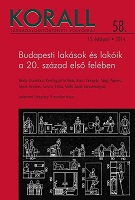Dobócia történetei: a Belső-Erzsébetváros a pesti köztudatban a két világháború között
Tales of Dobócia: Popular Images of the Inner 7th District of Budapest in the Interwar Period
Author(s): Erika SzívósSubject(s): History
Published by: KORALL Társadalomtörténeti Egyesület
Summary/Abstract: The author discusses popular images of Belső-Erzsébetváros, the Inner 7th District of Budapest, between the two world wars, attempting to determine the prestige and reputation of the neighbourhood in the interwar public mind. The neighbourhood – which is often termed “the Old Jewish Quarter” of Budapest today – used to be nicknamed Dobócia after its characteristic street Dob utca (“Drum Street”). Dob utca has been the stereotypical residence of Jewish characters in several classic Jewish jokes, part and parcel of Budapest urban folklore up to this very day; that fact in itself indicates something important about the social and ethno-religious character of the neighbourhood, at least in the historical sense. The main question of the article is how the Inner 7th District related to other districts of Budapest in terms of its reputation, compared especially to those areas which were also noted for their Jewish residents in the 1920s and 1930s; how the position of “Dobócia” was perceived in the intra-Budapest social hierarchy in the interwar period, and how it was represented in Jewish urban folklore. First the author summarizes the results of recent scholarship in urban and social history (including her own research), aiming to characterize the Inner 7th District by its social composition, professional and economic profile and denominational mixture. She also comments on the neighbourhood’s physical condition and residential architecture, relative to the prestige of the area on the real estate market. Relying on the context provided by urban history, the author then presents various images of the Inner 7th District through three different types of narrative sources, namely interwar fiction, short stories and anecdotes written in the late 20th and early 21st centuries which portray interwar Jewish neighbourhoods from a retrospective angle, and a memoir published in the 2000s by a one-time resident. The author argues that the use of such subjective sources combines ideally with classic methods of urban history when recovering the past image of a historic neighbourhood.
Journal: Korall - Társadalomtörténeti folyóirat
- Issue Year: 2014
- Issue No: 58
- Page Range: 94-116
- Page Count: 23
- Language: Hungarian

